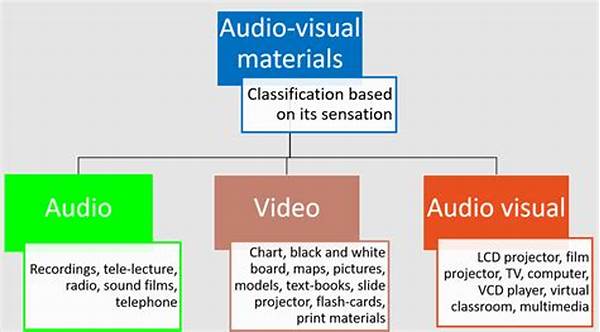Imagine a world where even the most remote village is connected to high-quality education resources, where every child has the opportunity to learn from the best educators regardless of their geographical location. It sounds utopian, doesn’t it? Yet, this vision is rapidly becoming a reality thanks to the innovative use of audio visual learning media. These tools break down geographical barriers, delivering educational content with engagement and effectiveness. In this blog, we will explore how audio visual learning media is transforming the rural education landscape.
Read More : Role Of Av In Interactive Museum Digital Experiences
In many rural areas, educational resources can be scarce. Textbooks are often outdated, and skilled teachers might be a luxury that not all schools can afford. However, through audio visual learning media, students gain access to a world of knowledge that is both diverse and current. Picture a classroom where students in a rural setting can dissect a virtual frog, explore the depths of the ocean, or even take a trip through outer space—all while sitting in their small classroom. The story of audio visual learning media is a tale of bridging gaps and igniting imaginations, offering rural students the chance to dream bigger and learn better.
The Power of Audio Visual Learning Media
Audio visual learning media that bridges the gap in rural education systems do so by providing an interactive and engaging learning experience. One key aspect is its unique selling point: the ability to convey complex concepts through visuals and sound, making information retention more effective. When students interact with dynamic content, they are more likely to maintain interest and focus.
Research and statistics consistently show that students retain information better when they see and hear something as opposed to traditional reading. Consider the testimony of several rural teachers who have implemented these tools in their classrooms. They report significant improvements in student engagement and understanding. In fact, studies indicate that audio visual aids can improve learning outcomes by 20% compared to non-interactive methods.
Moreover, the emotional and rational appeal of these media makes them genuinely engaging. A teacher might use a captivating video that tells the story of a historical event, drawing students emotionally into the experience, leading to deeper understanding and empathy. This multimedia approach does not simply communicate facts—it weaves stories that make learning an emotive and memorable journey.
Benefits of Using Audio Visual Learning Media
Enhancing Engagement in Rural Classrooms
The primary benefit of audio visual learning media that bridges the gap in rural education systems is heightened student engagement. In traditional learning settings, teachers confront challenges keeping students interested, especially when curriculum content may seem distant from the students’ everyday experiences. Video content, 3D animations, and interactive simulations create an immersive learning environment that grabs attention and keeps students curious and eager to learn more.
Interactive Learning Experience
Audio visual tools are also renowned for their capability to create interactive learning experiences. This feature is particularly effective in rural schools where resources are limited. Students can engage with content that offers instant feedback, encouraging participation and critical thinking skills.
Expanding Access and Reach
Furthermore, these media provide unparalleled access to quality education. With the expansion of internet services into rural areas, students and educators now have access to a wealth of information previously beyond their reach. A teacher might not know how to effectively explain a scientific process, but with a well-designed animation or video tutorial, students receive clarity and understanding.
Examples and Objectives of Audio Visual Learning Media in Rural Areas
Audio visual learning media that bridges the gap in rural education systems does so through various methods and tools. Here are some examples and objectives they aim to achieve:
Read More : Types Of Audio Visual Advertising Displayed Using Media In Augmented Reality
How Audio Visual Media Overcomes Rural Education Barriers
Bridging the Resource Gap
The use of audio visual learning media is like deploying digital teachers alongside traditional ones. They serve as powerful allies in rural education, providing resources that were once unattainable. Incorporating these tools allows rural schools to offer a more comprehensive curriculum, often comparable with urban schools.
Bringing Subject Matter to Life
Dynamic content delivery via these media means lessons are not just taught—they are experienced. Subjects that might traditionally cause students to lose interest are brought to life, making concepts that seemed irrelevant suddenly fascinating and accessible.
Strengthening Teacher Support
Importantly, audio visual learning media also supports teachers. It provides them with tools that help them explain complex ideas more clearly and allows them to focus on facilitating rather than just delivering instruction. Interviews with teachers confirm that these aids boost confidence and effectiveness, enhancing their teaching methods.
Conclusion: The Future of Rural Education
A Promising Horizon
As audio visual learning media continues to evolve, the future for rural education looks promising. These tools not only bridge geographic gaps but are transforming educational experiences, ensuring that every child has the opportunity to shine, irrespective of their location.
Building a Bridge to the Future
The narrative of audio visual learning media that bridges the gap in rural education systems is one of innovation and hope. It’s a story of educators, families, and communities coming together with the help of technology to ensure that no child is left behind. This journey is just beginning, and as it unfolds, it promises to offer even more exciting opportunities for rural learners worldwide. So, join us on this incredible mission to refashion rural education, creating a world where potential is not limited by postcode, but enhanced by possibility.
